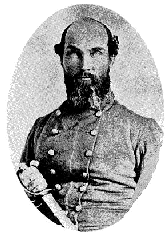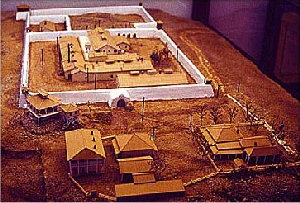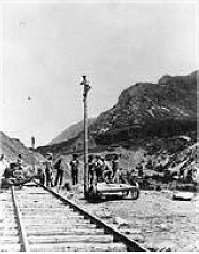Mexican-American War
In 1835, Texas declared independence from Mexico and Santa Anna led his army in to crush the rebellion. In 1846, the ideology of Manifest
Destiny and the occupation of disputed territory dispute over the United States annexation of Texas led the United States to initiate
the
Mexican-American War.
Shortly after the war began in 1846, Tucson was occupied by Army Captain Philip St. George Cooke
and the Mormon Battalion, raising the U.S. flag over the town for the first time. The road the battalion built to Tucson became a
major route for travelers to and from California.
The U.S. occupied Mexico City and forced the newly founded Mexican Republic to give
up its northern half, including the later Arizona. The
Treaty of Guadalupe Hidalgo (1848) ended the Mexican-American war and specified
that the U.S. pay Mexico the sum of $15 million in compensation for lands transferred to the U.S. extending the boundaries of the
United States west to the Pacific Ocean. The treaty not withstanding, Tucson was now within an area disputed by the U.S. and Mexico
and it's status won't be clear until the Gadsden Purchase clarifies the borders.
The Gadsden Purchase
After the end of the Mexican-American War in 1848, the border disputes between the United States and Mexico remained unsettled. In
addition, the U.S. government was looking for a southern route for a transcontinental railroad. In an effort to resolve the lingering
border disputes and provide for the railroad route, the U.S. negotiated the
Gadsden Purchase with Mexico. On December 30, 1853, U.S.
Minister to Mexico James Gadsden and Mexican President Antonio López de Santa Anna agreed on the price of $10 million for the Gadsden
land. With the treaty signing, Arizona became part of U.S. (New Mexico) territory.
It wasn't until the Gadsden Purchase (also known
as the Treaty of La Mesilla), effective in June 1854, that Tucson, Yuma, Sierra Vista or any other part of Southern Arizona was
officially part of America. Troops didn't show up until March 1856 to take possession. By that time the town had been growing due
to the additional commerce brought in by people on their way to the gold strikes in the west.
In 1849, the California Gold Rush
led as many as 50,000 miners through the region. In 1857, the area became a stage stop for the Overland Stage lines between San Diego
and San Antonio. This was a well-used route by travelers. Tucson became a major supply center during the civil war both for soldiers
and for miners.
Arizona Territory
In 1864 when
Arizona became a separate territory (to the chagrin of New Mexico territory), Tucson, the most populated and important
trading center in Arizona, was denied the territorial capital because Anglo-Americans were fearful that the already powerful and influential
Mexican-Americans would dominate local and territorial politics.
The first capital was at
Fort Whipple outside of Prescott, followed
by Prescott itself, in the northern Union-controlled area. In 1867, following the end of the Civil War, the capital was moved to Tucson
where it remained for the years 1867 to 1877. In 1877 it was moved back to Prescott and in 1889 it was finally moved to Phoenix, where
it remains.
The first military telegraph line hooked Tucson with the rest of the world in 1873. Territorial status brought Army
protection and settlers willing to risk the dangers to establish new towns and cities throughout the territory.
This website was created and is maintained by:
Philip J. June
Tucson, AZ
This website was first created
and published on 11.27.07;
Last update was 11.27.07
Hotel Ruins at Jerome Arizona
Site of Largest Copper Mine in Arizona
The Gadsden Purchase
Governor John R. Baylor
Confederate Territory of Arizona
Apaches - 1907
Capitol Building in Prescott - 1910
Model of the Yuma Territorial Prison - 1875
Kitt Peak National Observatory
Gold, Silver, Copper and Miners
During the years between the Gadsden Purchase and the Civil War, the population of Arizona was a mixture of Spaniards, Mexicans, Indians, and anglos from the eastern U.S. Although silver was discovered in Arizona by a Yaqui Indian in 1736, silver and gold strikes in the 1840's and 1850's enticed thousands of adventurers to travel west. Large numbers of prospectors, crossing Arizona to join the California gold rush, found gold, silver, and a neglected metal—copper.
In 1850 the New Mexico Territory was authorized with most of Arizona included as part of that new territory. In the 1850's the Colorado River crossing at Yuma became a major route for gold seekers from the East. The gold trail led through New Mexico, Tucson, and Yuma to California. From 1854 until 1858, Yuma was known as Colorado City, from 1858 until 1873, it was named Arizona City. Yuma received its present name by the Territorial Legislature in 1873.
Mining flourished, and by the following decades the Copper Queen Company at Bisbee was exploiting one of the area's largest copper deposits. In 1877 silver was discovered at Tombstone, setting off a boom that drew throngs of prospectors to Arizona but lasted less than 10 years.
The region had been held precariously by U.S. soldiers during the intermittent warfare (1861–86) with the Apaches, who were led by Cochise and later Geronimo. General George Crook waged a successful campaign against the Apaches in 1882–85, and in 1886 Geronimo finally surrendered to federal troops. The Army established Fort Yuma in 1853 to protect the hordes of goldseekers and to keep the Indians at bay.
The Civil War
At the outbreak of the Civil War, sentiment in the territory was in
favor of the Confederacy. Settlers in the territory felt betrayed
by the government in Washington which ignored their pleas for more protection from the Indians, surveys to ensure their claims on
the land, and more effective law enforcement.
According to an article in the Tucson Weekly Arizonian of August 10, 1861, "We are hemmed
in on all sides by the unrelenting Apache. Since the withdrawal of the Overland Mail and the garrison troops the chances against life
have reached the maximum height. Within six months nine-tenths of the whole male population have been killed off, and every ranch,
farm and mine of the country have been abandoned in consequence."
Territorial secession conventions were called at Mesilla and Tucson
in March 16, 1861 that adopted an Ordinance of Secession that declared itself independent of the United States and established the
provisional Confederate Territory of Arizona.
Captain Sherod Hunter rode in with 200 mounted Texans on February 28, 1862, to take
the town of Tucson for the Confederacy, there was no resistance. Union supporters left and the confederate flag was hoisted. The rebel
forces soon got word, though, that Colonel James H. Carleton, was coming east from California with his 1,500 man California Column
and would be arriving first in Yuma, then Tucson. There was a
skirmish at Picacho Pass April 15, 1862 north of town between an advance
guard of the Column and scouts from the rebel force. This was the only Civil War battle to be fought in Arizona. Colonel (later General)
Carelton and the California Volunteers
recaptured Tucson in June 1862 and drove out Confederate forces, putting Arizona back under
Union control, making Tucson now part of the U.S. again (New Mexico Territory).

Mexican-Spanish War
Mexico War of Independence
Spanish rule of southern Arizona ends with the Mexico War of Independence. On September 16, 1810, the rebel leader
Miguel Hidalgo,
the Creole parish priest of the small town of Dolores, Mexico decided to strike out for independence by marching on Mexico City. Thus
began the
Mexican-Spanish War. After a decade of war the Mexican revolutionaries eventually won and Mexico gained it's independence
from Spain.
On August 24, 1821, representatives of the Spanish crown and Iturbide signed the
Treaty of Córdoba, which recognized Mexican
independence. The settlers of the Tucson Presidio and all of southern Arizona were now citizens of Mexico and part of the State
of Vieja California. The northern part of Arizona was still under Indian control at this time. Phoenix and Flagstaff had
not yet been settled.
Arizona
The
Grand Canyon State
History of

The first permament residents of
Yuma settled around Fort yuma in 1858. It was known as Colorado City at that time. In
1858 the name was changed to Arizona City, and after a flood in 1864 that virtually wiped out the town (flooding from the Colorado
was common), the city was rebuilt and renamed Yuma. By July 1876 Yuma was Arizona's second largest city approximately 1,200
residents. The town was reported to contain: 11 saloons, 9 general stores, 1 drug store, 1 barber shop, 2 harness shops, 1 machine
shop; 3 blacksmith and wagon shops, 1 livery stable; 2 hotels, 1 newspaper, 4 lawyers, 2 doctors, 2 notaries and 1 district judge.
In
1875 the Eighth Territorial Legislature
proposed a bill calling for the establishment of a penitentiary. Granville H. Oury introduced
the legislation which would have placed the Territorial Prison in the Phoenix area but representatives from Yuma, Jose Maria Rendondo
and R. B. Kelly, inserted the name Yuma where Phoenix had been and Governor Anson P.K. Safford signed the bill, resulting in the Territorial
Prison built in Yuma. Between the years of 1875 and 1909 the
Yuma Territorial Prison held some of the most notorious desperados of
the old southwest.


Geronimo
Yuma
Installing the Telegraph Lines





























